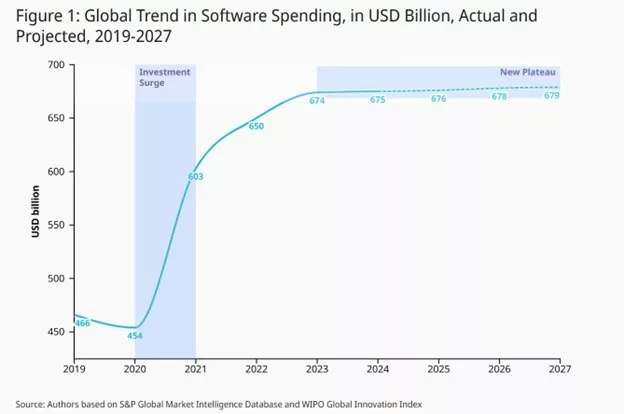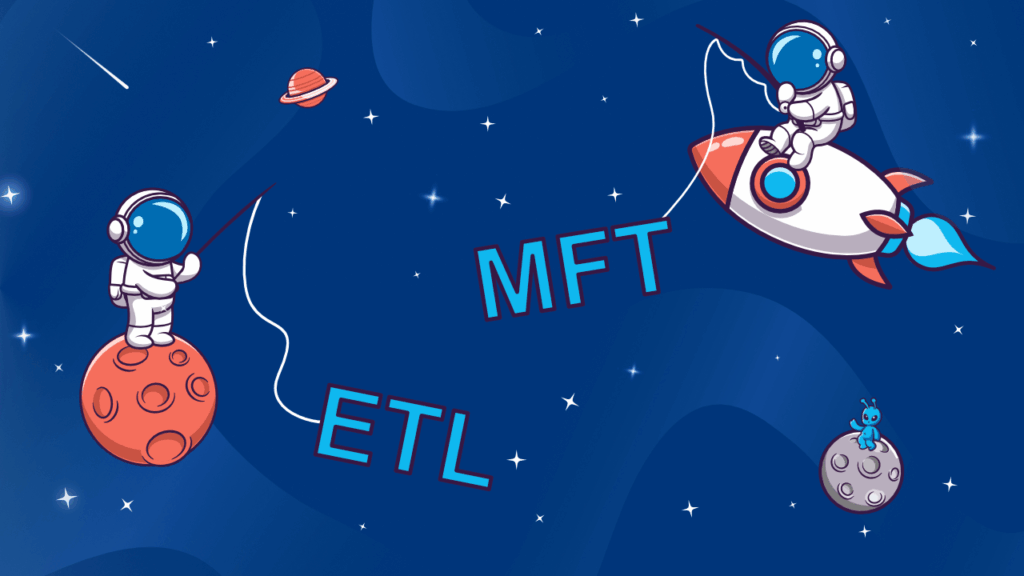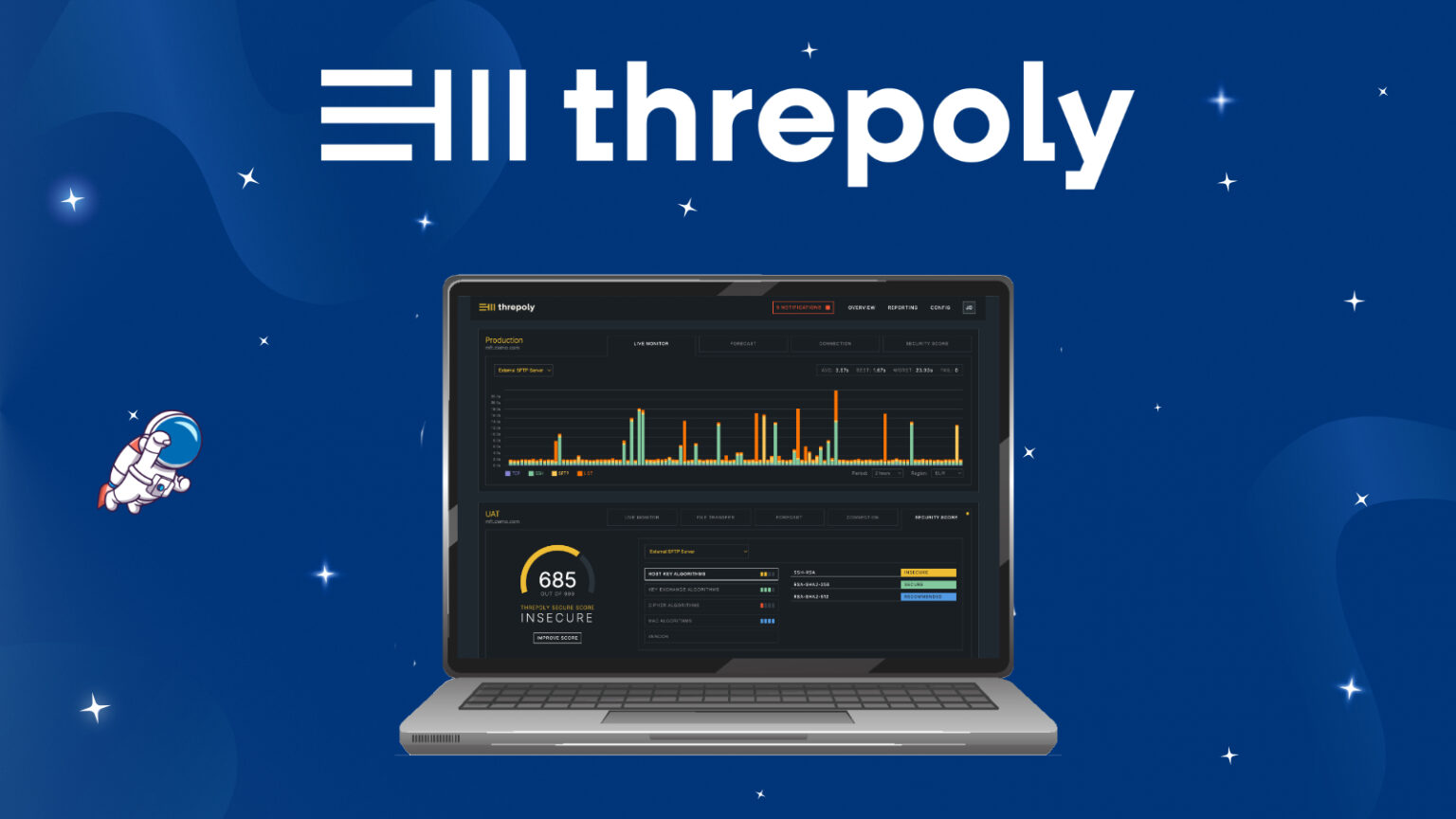Companies today are faced with a wide choice of technological solutions for managing, transforming and securing information flows. In just a few years, the IT market has become highly competitive and fast-moving.
Digital figures, between competition and evolution
In 2024, worldwide spending on software reached USD 675 billion, an increase of almost 50% compared to 2020 (USD 454 billion)1.

In 2016, there were an estimated 21 million professional software developers/engineers². This figure rose to around 28 million in 20233, and is expected to reach ≈28.7 million in 20252. The massive creation of companies and the boom in IT employment are evidence of strong growth in the ecosystem. SaaS, cloud solutions and digital transformation platforms have become the norm for more than 90% of businesses in 2023.
The software market is continuing to grow at a rate of 5% to 8% per year and is not about to stop.5
However, today we are going to focus on two major types of solution that dominate the market: ETL (Extract, Transform, Load) tools and MFT (Managed File Transfer) solutions, which are becoming increasingly popular for their simplicity, security and efficiency. While ETLs have long been the standard for data integration projects, MFT is now emerging as an increasingly popular solution.
Understanding the fundamental difference between ETL and MFT
ETL
Historically, ETL solutions have been designed to extract data from several sources (databases, flat files, APIs), transform it according to complex business rules, then load it into data warehouses or target systems. They are mainly used for business intelligence analysis, data lakes and business repository synchronisation.
Tools such as Talend and Informatica offer powerful data processing capabilities, but their implementation is often cumbersome, costly and inflexible. They require specialist developers, a robust infrastructure and a long development cycle. What’s more, the cost of licensing these solutions can run into the hundreds of thousands of euros for enterprise deployments.
MFT
In contrast, MFT (Managed File Transfer) solutions focus on secure, automated and supervised file transfers. They guarantee the integrity of data in transit, and offer advanced traceability, alert and automatic recovery functions. Historically seen as solutions limited to simple data transfers, modern MFT platforms now incorporate simple data transformation functions, intelligent workflows and connectors to a wide range of ERP, CRM and cloud systems. They can also be complemented by cybersecurity solutions such as inspection, sanitisation and recognition of sensitive data.

Case studies by business sector
1- Finacial sector
Let’s take the example of the banking sector, where the security of exchanges is crucial. A major banking institution recently replaced its ETL infrastructure with an MFT solution to orchestrate exchanges between its subsidiaries, financial partners and regulatory authorities. Whereas ETL required complex developments for each flow, MFT enabled rapid configuration via a graphical interface, with deployment times reduced by 60%, while meeting strict compliance requirements (encryption, logs, audit, etc.).

2- Healthcare sector
In the healthcare sector, hospitals and laboratories have to exchange sensitive files on a daily basis, such as biological results, medical records, financial data for insurance purposes, and so on. Using an MFT solution not only ensures compliance with regulations such as RGPD or HIPPA, but also delivers the operational fluidity that is essential for organisations with limited IT resources. Conversely, the use of an ETL would be oversized for this type of requirement, generating unjustified licence and maintenance costs.

3- Retail sector
In the retail sector, some distributors have replaced their ETL solution to automate the exchange of files with their suppliers (purchase orders, inventories, invoices) via an MFT platform. File transfers enable better supervision of exchanges, shorter lead times for bringing new partners into production and fewer human errors, all without the need for specialist developers.

4- Logistics sector
Finally, in the logistics sector, companies that have to interact with heterogeneous systems such as customs, carriers and e-commerce platforms find MFT an agile solution. Whereas an ETL requires a well-defined and stable schema, the MFT tolerates the diversity of formats and enables faster adaptation to the reality on the ground.
Gradual replacement of traditional ETLs
Today, many companies are reviewing their data processing architecture and questioning the value of maintaining heavy, costly ETL platforms, particularly when the use cases do not require advanced data transformation.
Migrations to MFT platforms, which handle up to 80% of the traditional data flows processed by ETLs, have become commonplace. According to a study published in 2024 by Research and Markets 4, more than 40% of companies surveyed had considered replacing their ETL infrastructure partially or totally with MFT, mainly for reasons of cost, maintenance and security.
The trend is also being reinforced by the rise of the hybrid cloud, where MFT is finding its place with its native SaaS connectors, whereas traditional ETLs are struggling to adapt without a major overhaul.
A significant difference in cost and deployment time
One of the major arguments in favour of MFT is its total cost of ownership. Whereas licences for ETL solutions can exceed €100,000 per year, a robust MFT solution can be implemented for a fraction of that price. What’s more, indirect costs (maintenance, skills upgrading, server infrastructure) are much lower. A study by Gartner in 2023 shows that the average cost of deploying an MFT is 3 to 5 times lower than that of a traditional ETL.
MFT also has the advantage in terms of time-to-production. Whereas an ETL project can take several months between design, development and testing, an MFT project can be operational in a few weeks, or even a few days for simple data flows.
Does the future of data integration lie with MFT?
It would be wrong to say that MFT systematically replaces ETL. The two approaches can coexist, depending on the nature of the data flows, the criticality of the transformations to be carried out and the business requirements. However, it is undeniable that many companies are rediscovering the virtues of simpler, faster and more secure integration thanks to Managed File Transfer.
In a tense economic climate, reducing costs and controlling risks are becoming priorities. Replacing an ETL solution such as Talend or Informatica with a well-chosen MFT solution not only meets current needs, but also enables you to adapt more quickly to future regulatory, technical or organisational changes.

Conclusion: it’s up to your business requirement
Companies looking to rationalise their information systems must now consider MFT as a serious alternative to traditional ETLs. Thanks to its ease of deployment, controlled costs, native security and flexibility, MFT meets a wide range of use cases, in all sectors of activity. This is not just a passing trend, but a real paradigm shift in the way we think about data integration. Choosing a modern MFT solution can be a major strategic and operational lever.
Sources :
1https://www.wipo.int/en/web/global-innovation-index/w/blogs/2025/global-software-spending
²https://wifitalents.com/software-industry-statistics/
3https://en.wikipedia.org/wiki/Software_engineering_demographics https://en.wikipedia.org/wiki/Managed_file_transfer
4https://www.globenewswire.com/fr/news-release/2024/11/18/2982627/28124/en/Managed-File-Transfer-Software-Services-Market-Report-2024-2029-by-Solution-Service-Deployment-and-Region-Increased-Adoption-of-Cloud-based-MFT-Solutions-Worldwide
5https://webtribunal.net/blog/cloud-adoption-statistics/
https://llcbuddy.com/data/managed-file-transfer-software-statistics/



